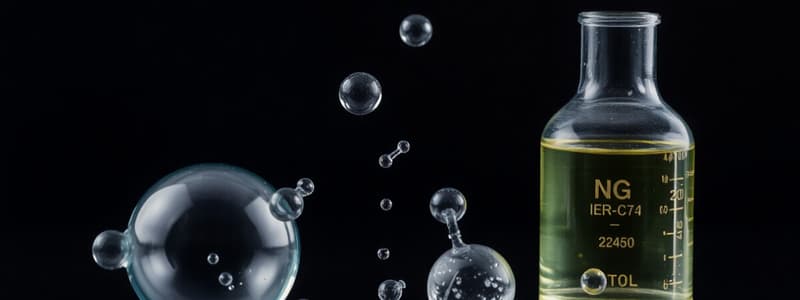Podcast
Questions and Answers
Which of the following BEST describes matter?
Which of the following BEST describes matter?
- A substance that cannot be broken down chemically
- Anything that has mass and occupies space (correct)
- A combination of substances chemically bonded
- Energy that can be converted into different forms
Which state of matter has a definite shape and volume?
Which state of matter has a definite shape and volume?
- Solid (correct)
- Gas
- Plasma
- Liquid
What is the simplest form of matter that cannot be broken down by chemical means?
What is the simplest form of matter that cannot be broken down by chemical means?
- Element (correct)
- Molecule
- Mixture
- Compound
What is a combination of substances that are physically combined but not chemically bonded?
What is a combination of substances that are physically combined but not chemically bonded?
Which of the following is an example of a physical property?
Which of the following is an example of a physical property?
Which particles are located in the nucleus of an atom?
Which particles are located in the nucleus of an atom?
What is the term for atoms of the same element with different numbers of neutrons?
What is the term for atoms of the same element with different numbers of neutrons?
Which type of chemical bond involves the sharing of electrons?
Which type of chemical bond involves the sharing of electrons?
What are the starting materials in a chemical reaction called?
What are the starting materials in a chemical reaction called?
Acids have a pH that is:
Acids have a pH that is:
Flashcards
What is Chemistry?
What is Chemistry?
The study of matter and its properties, including how matter changes.
What is Matter?
What is Matter?
Anything that has mass and occupies space (volume).
What are Elements?
What are Elements?
Simplest form of matter; cannot be broken down chemically.
What are Compounds?
What are Compounds?
Signup and view all the flashcards
What are Mixtures?
What are Mixtures?
Signup and view all the flashcards
What are Physical Properties?
What are Physical Properties?
Signup and view all the flashcards
What are Chemical Properties?
What are Chemical Properties?
Signup and view all the flashcards
What are Atoms?
What are Atoms?
Signup and view all the flashcards
What is a Molecule?
What is a Molecule?
Signup and view all the flashcards
What are Chemical Reactions?
What are Chemical Reactions?
Signup and view all the flashcards
Study Notes
Here are the study notes, updated with your provided text:
- Chemistry is the study of matter and its properties along with how that matter changes.
- Chemistry is a natural science focused on the properties, composition, structure, and transformations of matter.
Matter
- Matter is anything with mass that occupies space (volume).
- Matter exists as a solid, liquid, gas, and plasma.
- Solids have a definite shape and volume.
- Liquids have a definite volume and assume the shape of their container.
- Gases lack a definite shape or volume and are highly compressible.
- Plasma is an ionized gas carrying an electrical charge.
Composition of Matter
- Matter is composed of elements, the simplest substances, not broken down via chemical means.
- Elements are arranged in the periodic table by atomic number and chemical properties.
- Elements combine chemically to form compounds.
- Compounds consist of two or more elements bonded together.
- Compounds have distinct properties from their constituent elements.
- Mixtures are physically combined substances, not chemically bonded.
- Mixtures are either homogeneous (uniform) or heterogeneous (non-uniform).
Properties of Matter
- Physical properties are observed without changing composition, these include color, density, melting point, and boiling point.
- Chemical properties describe reactions with other substances, such as flammability and reactivity with acids.
- Intensive properties, such as temperature, pressure, and density, do not depend on the amount of substance.
- Extensive properties, such as mass and volume, depend on the amount of substance.
Atoms
- Atoms are the basic building blocks of matter.
- Atoms consist of protons, neutrons, and electrons.
- Protons are positively charged particles located in the nucleus.
- Neutrons are neutral particles in the nucleus.
- Electrons are the negatively charged particles orbiting the nucleus in energy levels or shells.
- The number of protons determines the atomic number and identifies the element.
- Isotopes are atoms of the same element with differing numbers of neutrons.
Molecules and Compounds
- Molecules are groups of two or more atoms held by chemical bonds.
- Compounds are molecules comprised of atoms from different elements.
- Chemical bonds are ionic through electron transfer or covalent through electron sharing.
- Ionic compounds form via interactions between metals and nonmetals.
- Covalent compounds form via interactions between nonmetals.
Chemical Reactions
- Chemical reactions involve the rearrangement of atoms and molecules to form new substances
- Reactants are the starting materials in a chemical reaction
- Products are the substances formed as a result of the reaction
- Chemical equations represent chemical reactions using symbols and formulas
- Balancing chemical equations ensures that the number of atoms of each element is the same on both sides of the equation, obeying the law of conservation of mass
Stoichiometry
- Stoichiometry deals with the quantitative relationships between reactants and products in chemical reactions
- The mole is the SI unit for measuring the amount of a substance
- Molar mass is the mass of one mole of a substance
- Stoichiometric calculations involve using mole ratios from balanced chemical equations to determine the amounts of reactants and products
Acids and Bases
- Acids are substances that donate protons (H⁺) or accept electrons
- Bases are substances that accept protons or donate electrons
- pH is a measure of the acidity or basicity of a solution
- Acids have a pH less than 7, bases have a pH greater than 7, and neutral solutions have a pH of 7
- Acid-base reactions involve the transfer of protons from an acid to a base, forming salt and water
Chemical Kinetics
- Chemical kinetics is the study of reaction rates and the factors that affect them
- Reaction rate is the change in concentration of reactants or products per unit time
- Factors affecting reaction rates include temperature, concentration, surface area, and catalysts
- Catalysts are substances that speed up a reaction without being consumed in the process
Chemical Thermodynamics
- Chemical thermodynamics deals with the study of energy and its transformations in chemical reactions
- Energy is the capacity to do work or transfer heat
- Enthalpy (H) is a measure of the heat content of a system
- Exothermic reactions release heat (ΔH < 0)
- Endothermic reactions absorb heat (ΔH > 0)
- Entropy (S) is a measure of the disorder or randomness of a system
- Gibbs free energy (G) is a measure of the spontaneity of a reaction
Solutions
- A solution is a homogeneous mixture of two or more substances
- The solute is the substance being dissolved, and the solvent is the substance doing the dissolving
- Concentration is the amount of solute present in a given amount of solvent or solution
- Solubility is the maximum amount of solute that can dissolve in a given amount of solvent at a specific temperature
- Factors affecting solubility include temperature, pressure, and the nature of the solute and solvent
Organic Chemistry
- Organic chemistry is the study of carbon-containing compounds
- Carbon can form stable bonds with itself and other elements, leading to a vast array of organic molecules
- Functional groups are specific groups of atoms within molecules that are responsible for the characteristic chemical reactions of those molecules
- Common functional groups include alcohols, aldehydes, ketones, carboxylic acids, and amines
- Isomers are molecules with the same molecular formula but different structural arrangements
Analytical Chemistry
- Analytical chemistry involves the qualitative and quantitative determination of the composition of substances
- Qualitative analysis identifies the components of a substance
- Quantitative analysis determines the amount of each component
- Techniques used in analytical chemistry include titrations, spectroscopy, and chromatography
Biochemistry
- Biochemistry is the study of chemical processes within living organisms
- It focuses on the structure and function of biomolecules such as proteins, carbohydrates, lipids, and nucleic acids
- Enzymes are biological catalysts that speed up biochemical reactions
- Metabolic pathways are sequences of chemical reactions that occur in cells to sustain life
Studying That Suits You
Use AI to generate personalized quizzes and flashcards to suit your learning preferences.
Description
Explore the basics of chemistry, including the definition of matter and its various states. Learn about the composition of matter, including elements and compounds, and how they combine.




